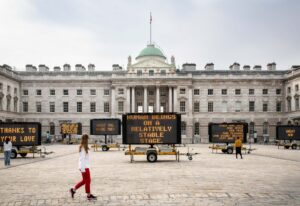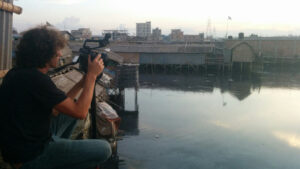
Justin Brice – Environmental Artist
Environmental artist Justin Brice encourages others to take a critical look at the relationship between humans and the planet.
Finland
Eva Baron May 14, 2021
Unpredictability is often what governs nature, with its crooked tree branches and dancing shadows. As encounters with these irregularities, Finnish visual artist Antti Laitinen’s work documents intimate and at times overlooked moments of natural transformation. Born and currently based in Finland, Laitinen centers his individual and artistic connections to his natural landscape, sailing across seas in self-crafted boats, cutting down and reassembling trees, and constructing small islands. Since 2005, these experimental and durational projects have been featured globally in exhibitions throughout the United Kingdom, Brazil, China, and Germany, among many other countries.
With an extensive background in multidisciplinary art, Laitinen explores a variety of mediums throughout his artistic process, ranging from photography, performance art, and sculpture. Humorous and introspective, Laitinen’s artwork endures as open-ended reflections on our relationship with our surrounding environment, inviting us to meditate upon time, our bodies, and nature’s essential unpredictability.
Mood of Living: Where are you from? Where did you grow up?
Antti Laitinen: At the moment I’m living in the south of Finland, but I’m originally from northern Finland. I moved to southern Finland about 20 years ago and I’ve been living here in Somero since.
MoL: Where did you go to school? Did you have a mentor?
AL: I went to school at the Turku Arts Academy in southern Finland. There were many good artists as teachers there, though I didn’t have any specific mentor. When I first started studying art, I didn’t think that I could be an artist—I believed that I’d become a photojournalist or something similar. While I was studying photography at school, though, I was interested in creating my own photography, not just taking photos for a newspaper. Later on, I stopped being a photojournalist and began creating my own art.
At first, I was a photographer but later I created different kinds of art. After Turku, I studied at the Academy of Fine Arts in Helsinki, the capital of Finland. There, I studied sculpture and performance art, for example.
MoL: What inspired you to become an artist?
AL: I’ve always been interested in photography. When I was young, I would create short films and then I realized that the more I made them, the shorter they’d get. When I was around 18-years-old, I saw Cindy Sherman’s photography for the first time, and I thought, “Wow! It’s only one photograph and it’s still telling a whole story.” I started exploring photography more and thought that I could also become a photographer.
MoL: What drew you to natural objects, such as trees, branches, and lakes, as artistic subjects?
AL: Early on, I was using a lot of water and building islands. I was most likely influenced by my surrounding environment. At that time, I was living by the sea and I was spending a lot of time in my summer house there. Ten years ago, when I moved to Somero where I’m living at the moment, I realized that we don’t have a sea nearby. There are a lot of trees around here, though. There are forests everywhere, so it’s very “countryside.” Because the trees surround me, I usually find ideas in them. Of course, when you’re making work, using materials, and in that artistic process, you might end up getting other ideas, too. So there’s being around trees constantly and getting ideas while working with materials.
When I graduated from school, I didn’t have a studio. Having grown up in the countryside, I thought, “Okay, I’ll go to the forest to work.” I was sucked into the forest as a studio: there was plenty of space and materials, like branches, ground, and water. I believe I started from there, but I never decided that these were going to be my materials that I would use as an artist. It was quite natural for me.
MoL: What is your creative process? Where do you gather inspiration for your artistic projects?
AL: Recently, I’ve been using a lot of trees. When I’m driving the car around Somero, I’m always looking above me and at these trees—how they’re curving, how they’re growing, and how I can capture that with my art. Now, the inspiration comes from seeing trees all the time, like when I’m walking in the forest or when I drive my daughter to kindergarten. I have to drive there every day, and I look at and think about how branches grow and how I can use those forms.
A lot of my ideas tend to come from what I’m seeing in my surrounding environment. I test these ideas, and sometimes they work and other times they don’t. I try to keep my eyes open.
MoL: As an artist, you explore notions of physical endurance and environmental unpredictability. How have projects such as Bark Boat and Three Stones informed your understanding of and your relationship to nature, your body, and art?
AL: At the time of Bark Boat, I had a studio on an island near Helsinki that we had to row to by boat when we went every day. On the island, there were many dead trees with raw, thick bark. In Finland, we have many pine trees and so almost every child will carve small bark boats out of the wood during their childhood. I found inspiration in this, and, while on the island, I started building small bark boats and began thinking, “is it possible to piece these small boats together to make a human-sized bark boat?”
I elaborated on these thoughts, and realized that it’d be great if I could sail with this larger bark boat on the water. When you’re a child and playing with these bark boats, you often imagine your boat sailing to the other side of the sea. I thought it’d be nice to actually accomplish that, to sail across the sea. I did the math, and concluded that the shortest distance to sail from Finland would be to Estonia. To me, it didn’t matter if I succeeded or not—the childlike idea of building and sailing my own bark boat across the sea was more interesting. Somehow, though, I did manage to sail to Estonia. It took about twenty hours.
Three Stones is one of my earlier works. At the time, I was thinking a lot about physical work and how value is often placed in how much time and how hard you’ve worked. Three Stones and a few other projects focused on the idea of sweat and how it could be used as a way to measure my physical work. I thought that incorporating sweat with my art would be intriguing. I tried to find techniques that would render my sweat visible, and photo paper seemed to work the best.
For Three Stones, I dug three holes to find stones. One took seven minutes, one seven hours, and one seven days. These photographs are accompanied with text that says how much time it took me to dig for and find these stones. Three Stones was a document of how much time I worked and how the stones, even though I spent different amounts of time digging for them, looked very similar in the end.
MoL: You work with a vast variety of materials, but which one has been your favorite and why? How do you navigate the disparate mediums with which you work?
AL: For a long time, I used water as my primary material. But at some point, I suppose I ran out of ideas or just wanted to experience new materials. Right now in Somero, I’ve been focusing on trees, but maybe in the future I’ll find another type of material that I’ll be interested in. Water and trees, though, are my two primary materials. I don’t know what my next focus will be.
MoL: How can we, both as artists and as citizens, combat the urgency of climate change today? How do you address this through your art, if at all?
AL: In my art, I’m of course thinking about the climate and the environment, but it’s not my starting point or necessarily the main subject in my work. I also prefer allowing my work to be very open to interpretation—if you can see a message about the climate and climate change in some work, then that’s great. If you don’t, then that’s also great.
MoL: How has your artistic process evolved during COVID? How has COVID impacted the way you understand nature as well as art?
AL: Since I’m currently living in the countryside and hardly see anyone both before and during COVID, it hasn’t impacted my work in the same way as others. Before COVID, though, I was of course able to travel a few times a year to create art in other countries, but at the moment that isn’t possible. Because I’m in nature and working outside as I create my art, I don’t come into contact with COVID. There are definitely artists that are more affected by COVID than I have been.
MoL: What advice can you give to future artists who want to make a positive impact in today’s world?
AL: I think you have to follow your own ideas. You can’t calculate too much or predict what people want—it’s more about what you are interested in, because that’s more authentic. People can see what’s real, too. It’s better to follow your own path than think about the kind of art that people want and fit into that mold.
Photography and video courtesy of Antti Laitinen

Environmental artist Justin Brice encourages others to take a critical look at the relationship between humans and the planet.

Internationally recognized filmmaker Andrew Morgan focuses on telling stories for a better tomorrow for various film and new media projects.

Throughout his work with Ala Plástica and Casa Río Lab, environmental activist and artist Alejandro Meitin unites social engagement, art, and sustainability.